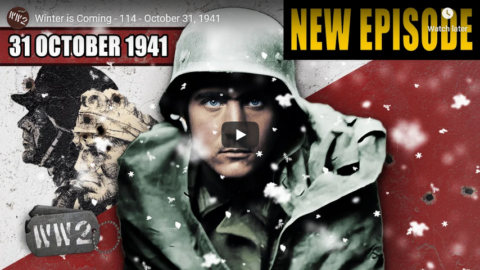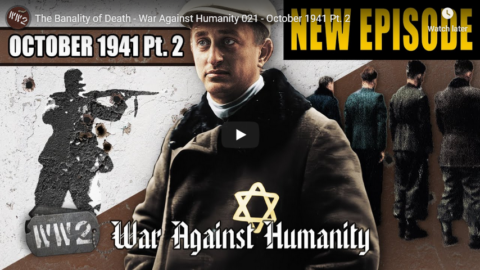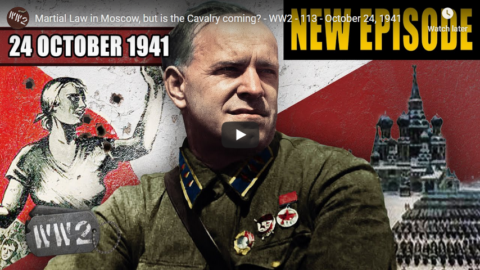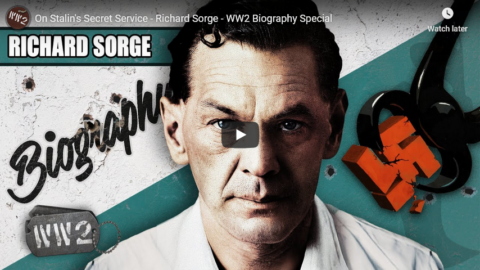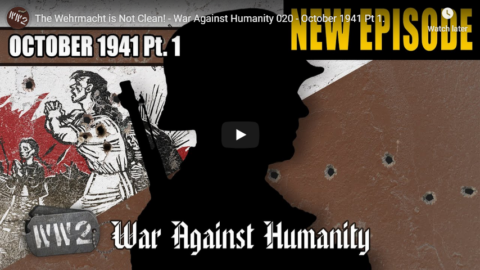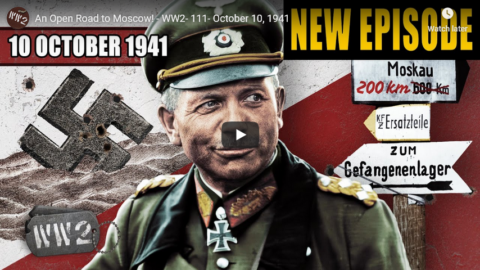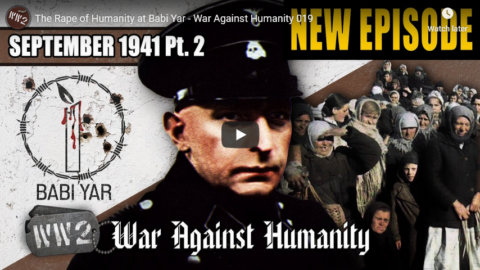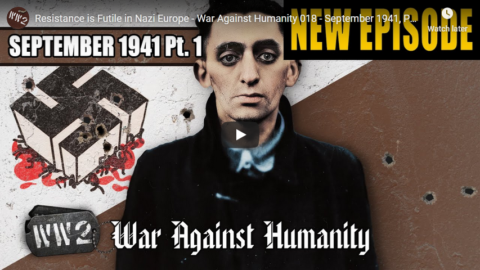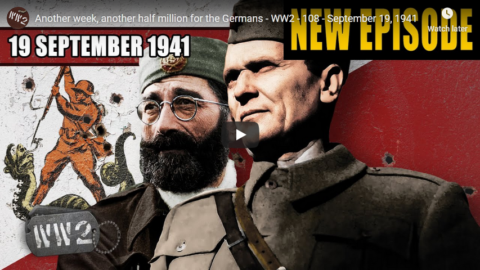World War Two
Published 31 Oct 2020Operation Typhoon is halted until the coming winter can freeze enough ground to increase mobility. But the ever colder weather is a disaster waiting to happen for an already over-stretched German supply line.
Join us on Patreon: https://www.patreon.com/TimeGhostHistory
Or join The TimeGhost Army directly at: https://timeghost.tvFollow WW2 day by day on Instagram @ww2_day_by_day – https://www.instagram.com/ww2_day_by_day
Between 2 Wars: https://www.youtube.com/playlist?list…
Source list: http://bit.ly/WW2sourcesWritten and Hosted by: Indy Neidell
Director: Astrid Deinhard
Producers: Astrid Deinhard and Spartacus Olsson
Executive Producers: Astrid Deinhard, Indy Neidell, Spartacus Olsson, Bodo Rittenauer
Creative Producer: Maria Kyhle
Post-Production Director: Wieke Kapteijns
Research by: Indy Neidell
Edited by: Miki Cackowski
Sound design: Marek Kamiński
Map animations: Eastory (https://www.youtube.com/c/eastory)Colorizations by:
Mikolaj Uchman
Dememorabilia – https://www.instagram.com/dememorabilia/
Jaris Almazani (Artistic Man) – https://instagram.com/artistic.man?ig…Sources:
Bundesrchiv
Narodowe Archiwum Cyfrowe
Yad Vashem 7283/146Soundtracks from the Epidemic Sound:
Johannes Bornlof – “Death And Glory 2”
Johan Hynynen – “Dark Beginning”
Johannes Bornlof – “The Inspector 4”
Hakan Eriksson – “Epic Adventure Theme 4”
Farell Wooten – “Blunt Object”
Fabien Tell – “Last Point of Safe Return”Archive by Screenocean/Reuters https://www.screenocean.com.
A TimeGhost chronological documentary produced by OnLion Entertainment GmbH.
November 1, 2020
October 31, 2020
The Banality of Death – War Against Humanity 021 – October 1941 Pt. 2
World War Two
Published 29 Oct 2020French resistance members liquidate a high-ranking German officer, triggering a series of retaliatory actions by the German occupiers. Meanwhile, actions in the “Holocaust of Bullets” continue in the east as German forces move further into the USSR, taking Odessa.
Join us on Patreon: https://www.patreon.com/TimeGhostHistory
Or join The TimeGhost Army directly at: https://timeghost.tvFollow WW2 day by day on Instagram @ww2_day_by_day – https://www.instagram.com/ww2_day_by_day
Between 2 Wars: https://www.youtube.com/playlist?list…
Source list: http://bit.ly/WW2sourcesHosted by: Spartacus Olsson
Written by: Joram Appel
Director: Astrid Deinhard
Producers: Astrid Deinhard and Spartacus Olsson
Executive Producers: Astrid Deinhard, Indy Neidell, Spartacus Olsson, Bodo Rittenauer
Creative Producer: Maria Kyhle
Post-Production Director: Wieke Kapteijns
Research by: Joram Appel
Edited by: Miki Cackowski
Sound design: Marek Kamiński
Map animations: Eastory (https://www.youtube.com/c/eastory)Colorizations by:
Mikołaj Uchman
Julius Jääskeläinen – https://www.facebook.com/JJcolorization/
Norman Stewart – https://oldtimesincolor.blogspot.com/
Jaris Almazani (Artistic Man) – https://instagram.com/artistic.man?ig…
Carlos Ortega Pereira – BlauColorizations, https://www.instagram.com/blaucolorizations
Tzo15 – https://commons.wikimedia.org/wiki/Fi…Sources:
– Berkhoff, Karel (ed.), Basic Historical Narrative of the Babi Yar Holocaust Memorial Center (2018).
– Cobb, Matthew, The Resistance (2009).
– Desbois, Patrick, The Holocaust by Bullets: A Priest’s Journey to Uncover the Truth Behind the Murder of 1.5 Million Jews (2008).
– Fox, Holquist and Martin, The Holocaust in the East: Local Perpetrators and Soviet Responses (2014).
– Kay, Alex and David Stahel, Mass Violence in Nazi-Occupied Europe (2018).
– Klee, Dressen and Reiss, The Good old Days: The Holocaust as Seen by Its Perpetrators and Bystanders (1991).
– Longerich, Peter, The Unwritten Order: Hitler’s Role in the Final Solution (2001)
– Longerich, Peter, Holocaust: The Nazi Persecution and Murder of the Jews (2010).
– Mitter, Rana, Forgotten Ally: China’s World War II, 1937-1945 (2013).
– Müller, “The Brutalisation of Warfare, Nazi Crimes and the Wehrmacht”, In: Erickson & Dilks, Barbarossa: The Axis and the Allies.
– Parrish, Michael, The Lesser Terror Soviet State Security, 1939-1953.
– Rutherford, Jeff, Combat And Genocide on the Eastern Front: The German Infantry’s War, 1941-1944 (2014).
– Snyder, Timothy, Bloodlands: Europe Between Hitler and Stalin (2010).
– United States Holocaust Memorial Museum, Encyclopaedia of Camps and Ghettos, 1933-1945, volume II, Part A (2012).
– United States Holocaust Memorial Museum, Encyclopaedia of Camps and Ghettos, 1933-1945, volume II, Part B (2012)Visual sources:
Yad Vashem 75EO4, 933/3/5, 94DO1, 75FO4, 75DO3, 3065/2, 4359/45, 2725/6, 86FO2, 3199/5, 7904/172, 3745/138, 90FO3, 4359/83, 4359/21, 4359/55, 4216/34, 86DO8, 3150/129, 4613/89, 142BO7, 3150/122
Bundesarchiv
Visuotinė lietuvių enciklopedija
Narodowe Archiwum Cyfrowe
Picture of Lavrentiy Beria in court, courtesy of Фотограф – Ист.доки https://commons.wikimedia.org/wiki/Fi…
Picture of Gilbert Brustlein, courtesy of Fbrustlein https://commons.wikimedia.org/wiki/Fi…
Picture of Jewish officials of the Vilnius ghetto, courtesy of United States Holocaust Memorial Museum, William Begell
Picture of Jewish and Lithuanian police guarding the entrence to the Vilnius ghetto, courtesy of United States Holocaust Memorial Museum, William Begell
from the Noun Project: Skull by Muhamad Ulum, students by Piotrek Chuchla, person by Adrien Coquet, Injury by Adraino Emerick, Man by Milinda Courey, Woman by Maxim Kulikov, Child by RocketDictionSoundtracks from Epidemic Sound:
Reynard Seidel – “Deflection”
Johannes Bornlof – “The Inspector 4”
Johannes Bornlof – “Deviation In Time”
Farell Wooten – “Blunt Object”
Peter Sandberg – “Document This 1”
Gunnar Johnsen – “Not Safe yet”
Jon Bjork – “For the Many”Archive by Screenocean/Reuters https://www.screenocean.com.
A TimeGhost chronological documentary produced by OnLion Entertainment GmbH.
October 25, 2020
October 23, 2020
October 18, 2020
Russian Civil War in Central Asia I THE GREAT WAR 1920
The Great War
Published 17 Oct 2020Sign up for Curiosity Stream and get Nebula bundled in: https://curiositystream.com/thegreatwar
By the fall of 1920, the Russian Civil War had unleashed three years of ethnic and internal conflict in Central Asia, and there was no end in sight. In this episode we’ll catch up on the dramatic events of the former Russian imperial lands in Central Asia from the revolution right up to the end of 1920, 100 years ago.
» SUPPORT THE CHANNEL
Patreon: https://www.patreon.com/thegreatwar» OUR PODCAST
https://realtimehistory.net/podcast – interviews with World War 1 historians and background info for the show.» BUY OUR SOURCES IN OUR AMAZON STORES
https://realtimehistory.net/amazon *
*Buying via this link supports The Great War (Affiliate-Link)» SOURCES
Baumann, Robert F. Russian-Soviet Unconventional Wars in the Caucasus, Central Asia, and Afghanistan, Combat Studies Institute, 2010.Becker, Seymour. Russia’s Protectorates in Central Asia: Bukhara and Khiva, 1865-1924, RoutledgeCurzon, 2004.
Brower, Daniel R. Turkestan and the Fate of the Russian Empire, Routledge, 2010.
Buttino, M. “Study of the Economic Crisis and Depopulation in Turkestan, 1917–1920”, Central Asian Survey, no. 4, 1990, pp. 59-74, doi:10.1080/02634939008400725.
Campbell, Ian W. Knowledge and the Ends of Empire: Kazak Intermediaries and Russian Rule on the Steppe, 1731-1917, Cornell University Press, 2017.
Everett-Heath, Tom. Central Asia: Aspects of Transition, Routledge, 2003.
Hiro, D. Inside Central Asia, Abrams, 2011.
Keller, Shoshana. Russia and Central Asia: Coexistence, Conquest, Convergence, University of Toronto Press, 2020.
Khalid, A. “Central Asia Between the Ottoman and the Soviet Worlds”, Kritika: Explorations in Russian and Eurasian History, no. 2, 2011, pp. 451-76, doi:10.1353/kri.2011.0028.
Khalid, Adeeb. “The Bukharan People’s Soviet Republic in the Light of Muslim Sources”, Die Welt Des Islams, no. 3, 2010, pp. 335-61, doi:10.1163/157006010×544287.
Khalid, Adeeb. Making Uzbekistan: Nation, Empire, and Revolution in the Early USSR, Cornell University Press, 2019.
Khalid, Adeeb. The Politics of Muslim Cultural Reform: Jadidism in Central Asia, Oxford University Press, 2000.
Loring, B. “‘Colonizers With Party Cards’: Soviet Internal Colonialism in Central Asia, 1917–39”, Kritika: Explorations in Russian and Eurasian History, no. 1, 2014, pp. 77-102, doi:10.1353/kri.2014.0012.
Olcott, M. B. “The Basmachi or Freemen’s Revolt in Turkestan 1918–24”, Soviet Studies, no. 3, 1981, pp. 352-69, doi:10.1080/09668138108411365.
Poujol, Catherine. “Jews and Muslims in Central Asia”, A History of Jewish-Muslim Relations: From the Origins to the Present Day, edited by Abdelwahab Meddeb, Benjamin Stora, Jane Marie Todd and Michael B. Smith, Princeton University Press, Princeton; Oxford, 2013, pp. 258–268.
Sahadeo, Jeff. Russian Colonial Society in Tashkent: 1865-1923, Indiana University Press, 2010.
Sokol, Edward D. The Revolt of 1916 in Russian Central Asia, Johns Hopkins University Press, 2016.
» MORE THE GREAT WAR
Website: https://realtimehistory.net
Instagram: https://instagram.com/the_great_war
Twitter: https://twitter.com/WW1_Series
Reddit: https://reddit.com/r/TheGreatWarChannel»CREDITS
Presented by: Jesse Alexander
Written by: Jesse Alexander
Director: Toni Steller & Florian Wittig
Director of Photography: Toni Steller
Sound: Toni Steller
Editing: Toni Steller
Motion Design: Philipp Appelt
Mixing, Mastering & Sound Design: http://above-zero.com
Maps: Daniel Kogosov (https://www.patreon.com/Zalezsky)
Research by: Jesse Alexander
Fact checking: Florian WittigChannel Design: Yves Thimian
Original Logo: David van StepholdContains licensed material by getty images
All rights reserved – Real Time History GmbH 2020
October 16, 2020
The Wehrmacht is Not Clean! – War Against Humanity 020 – October 1941 Pt 1
World War Two
Published 15 Oct 2020The Wehrmacht is deeply involved with the Nazis’ War Against Humanity. They are complicit in the murder of thousands of Jews in the “Holocaust of Bullets”, and the severe treatment of Soviet Prisoners of War. In October 1941, Wehrmacht General Walther von Reichenau issues the “Severity Order”, taking away any ambiguity there may be as to the Wehrmacht‘s vision.
Join us on Patreon: https://www.patreon.com/TimeGhostHistory
Or join The TimeGhost Army directly at: https://timeghost.tvFollow WW2 day by day on Instagram @ww2_day_by_day – https://www.instagram.com/ww2_day_by_day
Between 2 Wars: https://www.youtube.com/playlist?list…
Source list: http://bit.ly/WW2sourcesHosted by: Spartacus Olsson
Written by: Joram Appel and Spartacus Olsson
Director: Astrid Deinhard
Producers: Astrid Deinhard and Spartacus Olsson
Executive Producers: Astrid Deinhard, Indy Neidell, Spartacus Olsson, Bodo Rittenauer
Creative Producer: Maria Kyhle
Post-Production Director: Wieke Kapteijns
Research by: Joram Appel
Edited by: Miki Cackowski
Sound design: Marek Kamiński
Map animations: Eastory (https://www.youtube.com/c/eastory)Colorizations by:
Mikolaj Uchman
Klimbim – https://www.flickr.com/photos/2215569…
Jaris Almazani (Artistic Man) – https://instagram.com/artistic.man?ig…
Julius Jääskeläinen – https://www.facebook.com/JJcolorization/
Norman Stewart – https://oldtimesincolor.blogspot.com/Sources:
Berkhoff, Karel (ed.), Basic Historical Narrative of the Babi Yar Holocaust Memorial Center (2018).
Desbois, Patrick, The Holocaust by Bullets: A Priest’s Journey to Uncover the Truth Behind the Murder of 1.5 Million Jews (2008).
Fox, Holquist and Martin, The Holocaust in the East: Local Perpetrators and Soviet Responses (2014).
Kay, Alex and David Stahel, Mass Violence in Nazi-Occupied Europe (2018).
Longerich, Peter, The Unwritten Order: Hitler’s Role in the Final Solution (2001)
Longerich, Peter, Holocaust: The Nazi Persecution and Murder of the Jews (2010).
Mitter, Rana, Forgotten Ally: China’s World War II, 1937-1945 (2013).
Müller, “The Brutalisation of Warfare, Nazi Crimes and the Wehrmacht”, In: Erickson & Dilks, Barbarossa: The Axis and the Allies.
Paine, S. C. M., The Wars for Asia, 1911-1949 (2012).
Pieper, Henning, Fegelein’s Horsemen and Genocidal Warfare: The SS Cavalry Brigade in the Soviet Union (2015).
Rutherford, Jeff, Combat And Genocide on the Eastern Front: The German Infantry’s War, 1941-1944 (2014).
Snyder, Timothy, Bloodlands: Europe Between Hitler and Stalin (2010).
United States Holocaust Memorial Museum, Encyclopaedia of Camps and Ghettos, 1933-1945, volume II, Part A (2012).
United States Holocaust Memorial Museum, Encyclopaedia of Camps and Ghettos, 1933-1945, volume II, Part B (2012).
Porter, Thomas Earl, “Hitler’s Forgotten Genocides: The Fate of Soviet POWS”, in: Elon Law Review 5/259
Walter E. Grunden, “No retaliation in Kind: Japanese Chemical Warfare Policy in World War Two”, in: One Hundred Years of Chemical Warfare: Research, Deployment, Consequences (2017) 259-271.Visual sources:
Yad Vashem 4216/18, 4360/123, 7904/245, 143BO2, 6584677, 4147/65, 1044/148, 75FO4, 4220/2, 1249/67, 3745/140, 5705/34, 2725/23, 5705/47
USHMM
Bundesarchiv
www.auschwitz.org
FOTO:Fortepan — ID 73897, ID 28024
Picture of corpses of Auschwitz prisoners in Block 11 (Auschwitz I), courtesy of USHMM, Instytut Pamięci Narodowej
from the Noun Project: Skull by Muhamad Ulum, can by CCCHOI, gas bomb by Mete Eraydın from the Noun Project, Injury by Adriano EmerickSoundtracks from the Epidemic Sound:
Fabien Tell – “Never Forget”
Wendel Scherer – “Growing Doubt”
Jon Bjork – “Icicles”
Farrell Wooten – “Blunt Object”
Peter Sandberg – “Document This 1”
Gunnar Johnsen – “Not Safe Yet”
Andreas Jamsheree – “Guilty Shadows 4”Archive by Screenocean/Reuters https://www.screenocean.com.
A TimeGhost chronological documentary produced by OnLion Entertainment GmbH.
From the comments:
World War Two
7 hours ago (edited)
Two years into the World War Two channel, we’re still often confronted with stubborn myths regarding the responsibility for the crimes committed against humanity during the Second World War. We have already seen time and time again how the Wehrmacht is actively and passively complicit to the harsh treatment of civilians, the mishandling and killing of PoWs, the murder of local non-combatants, and the genocides committed by Nazi Germany. Let this episode be nail in that myth’s coffin. There is, unambiguously and unequivocally, no doubt about the Wehrmacht‘s awareness, intentions, actions, effects and complicity in the War Against Humanity.For our Polish speakers: while Spartacus’ less than perfect pronounciation of Polish names is usually at least an attempt, the pronounciation of Belzec is on pupose the English way of saying it, since the Polish pronounciation is not familiar to almost all non-Polish speakers, and it needs to be clear of what place he is speaking of.
October 15, 2020
This is what happens when politicians delegate too much of their powers to the courts
At the Foundation for Economic Education, Lawrence W. Reed recounts the stunning injustice of Soviet “justice”, in the person of Nikolai Krylenko:

Panorama of the west facade of United States Supreme Court Building at dusk in Washington, D.C., 10 October, 2011.
Photo by Joe Ravi via Wikimedia Commons.
As I watched the first day of hearings on Judge Barrett’s nomination, I was reminded of a largely forgotten Soviet legal theoretician from decades ago. His name was Nikolai Krylenko. Judge Barrett is being given the Krylenko treatment by Democrat senators like Cory Booker and Kamala Harris, meaning this: The only thing that matters is whether she will vote their party line in future cases.
Under the communist dictatorship of Lenin and then Stalin, Krylenko (1885-1938) rose through the Soviet Union’s legal system to become People’s Commissar for Justice and a Prosecutor General. He was a leading practitioner of the theory of “socialist legality,” which held that an accused person’s innocence or guilt depended on that person’s politics (real or imagined). It sounds nuts and indeed, it was. It was the stuff of Orwell’s nightmare, and one of the reasons the Soviet Union thankfully perished of its own poison.
In The Gulag Archipelago, the famous Soviet dissident and Nobel laureate Aleksandr Solzhenitsyn recounted an episode involving Krylenko. Shortly after Lenin’s Bolsheviks assumed power in 1917, an admiral named Shchastny was sentenced by one of the regime’s judges “to be shot within 24 hours.” When some in the courtroom expressed shock, it was Krylenko who responded thusly: “What are you worrying about? Executions have been abolished. But Shchastny is not being executed; he is being shot.”
To Krylenko, the only morality was what served the Party and the State, which of course in the Soviet Union were one and the same. If your politics were not correct, you would be “corrected,” one way or the other. In Richard Pipes’ authoritative book, The Russian Revolution, Krylenko is quoted as exclaiming, “We must execute not only the guilty. Execution of the innocent will impress the masses even more.”
At the Senate hearings for the Barrett nomination, it was apparent the first day that the Judge was being Krylenkoed. Hostile senators pronounced their verdicts before she had uttered a word, and those verdicts had nothing to do with Barrett’s stellar qualifications or keen legal mind. Legal analyst and George Washington University Law School professor Jonathan Turley commented,
What they were suggesting is that they will be voting against her because of what they expected her vote would be in a pending case, and that is a conditional confirmation … Here, the senators seem to be saying, “I’m not even going to listen; I’m going to vote against you because I don’t think you’re going to vote the right way …”
Judge Barrett clearly articulated her judicial philosophy, borne out by the way she has ruled at the US Court of Appeals for the Seventh Circuit: She believes the role of a judge or justice is to follow the Constitution and the law as written, not make stuff up in the service of a political agenda. How ironic that this is a point of fiery contention. Senators who swore an oath to uphold the Constitution and the law hate the guts of a judge who does just that!
October 11, 2020
October 4, 2020
October 2, 2020
The Rape of Humanity at Babi Yar – War Against Humanity 019
World War Two
Published 1 Oct 2020Killing Jews by the thousands becomes the main way of eradicating the Jews in Eastern Europe in August and September 1941. The Mass Murder at Babi Yar in Kiev is yet another escalation in that process.
Join us on Patreon: https://www.patreon.com/TimeGhostHistory
Or join The TimeGhost Army directly at: https://timeghost.tvCheck out our TimeGhost History YouTube Channel: https://www.youtube.com/c/timeghost?s…
Follow WW2 day by day on Instagram @ww2_day_by_day – https://www.instagram.com/ww2_day_by_day
Between 2 Wars: https://www.youtube.com/playlist?list…
Source list: http://bit.ly/WW2sourcesHosted by: Spartacus Olsson
Written by: Joram Appel and Spartacus Olsson
Director: Astrid Deinhard
Producers: Astrid Deinhard and Spartacus Olsson
Executive Producers: Astrid Deinhard, Indy Neidell, Spartacus Olsson, Bodo Rittenauer
Post-Production Director: Wieke Kapteijns
Creative Producer: Maria Khyle
Research by: Joram Appel
Edited by: Miki Cackowski
Sound design: Marek Kamiński
Map animations: Eastory (https://www.youtube.com/c/eastory)Colorizations by:
Carlos Ortega Pereira, BlauColorizations – https://www.instagram.com/blaucolorizations
Julius Jääskeläinen – https://www.facebook.com/JJcolorization/
Tzo15 https://commons.wikimedia.org/wiki/Fi…
Mikolaj Uchman
Spartacus OlssonImage Sources:
Bundesarchiv
Yad Vashem 3725/4, 7717/273, 5705/29, 5705/43, 3150/37, 5705/48, 5705/53, 5705/54, 5705/21, 2725/7, 5705/12, 5705/20, 5705/22, 4788/72, 5705/26, 5705/40, 4613/1055, 3521/134, 3521/133
USHMM
Narodowe Archiwum Cyfrowe
from the Noun Project: Skull by Muhamad Ulum, soldier by Simon ChildSoundtracks from the Epidemic Sound:
Cobby Costa – “Flight Path”
Andreas Jamsheree – “Guilty Shadows 4”
Jon Bjork – “For the Many”
Farell Wooten – “Blunt Object”
Fabien Tell – “Never Forget”
Gunnar Johnsen – “Not Safe Yet”Sources:
Berkhoff, Karel (ed.), Basic Historical Narrative of the Babi Yar Holocaust Memorial Center (2018).
Desbois, Patrick, The Holocaust by Bullets: A Priest’s Journey to Uncover the Truth Behind the Murder of 1.5 Million Jews (2008).
Fox, Holquist and Martin, The Holocaust in the East: Local Perpetrators and Soviet Responses (2014).
Kay, Alex and David Stahel, Mass Violence in Nazi-Occupied Europe (2018).
Longerich, Peter, The Unwritten Order: Hitler’s Role in the Final Solution (2001)
Longerich, Peter, Holocaust: The Nazi Persecution and Murder of the Jews (2010).
Klee, dressen and Reiss, The Good Old Days: The Holocaust as Seen by its Perpetrators and Bystanders (1991).
Müller, “The Brutalisation of Warfare, Nazi Crimes and the Wehrmacht”, In: Erickson & Dilks, Barbarossa: The Axis and the Allies.
Pieper, Henning, Fegelein’s Horsemen and Genocidal Warfare: The SS Cavalry Brigade in the Soviet Union (2015).
Rutherford, Jeff, Combat And Genocide on the Eastern Front: The German Infantry’s War, 1941-1944 (2014).
Snyder, Timothy, Bloodlands: Europe Between Hitler and Stalin (2010).
United States Holocaust Memorial Museum, Encyclopaedia of Camps and Ghettos, 1933-1945, volume II, Part A (2012).
United States Holocaust Memorial Museum, Encyclopaedia of Camps and Ghettos, 1933-1945, volume II, Part B (2012).Archive by Screenocean/Reuters https://www.screenocean.com.
A TimeGhost chronological documentary produced by OnLion Entertainment GmbH.
From the comments:
World War Two
3 hours ago
No one should have to go through what the subjects of todays episode went through. Every one of the 33,000 victims of the mass-murder at Babi Yar has their own personal story. They were humans, just like you and me, with memories, interests, hobbies, fears, hopes and loved ones. This is why we tried to make this episode as personal as we could – So that we don’t forget that we’re talking about real people here.
September 27, 2020
September 26, 2020
September 21, 2020
The Iconic “Burp Gun” – Shooting the PPSh-41
Forgotten Weapons
Published 16 Dec 2017http://www.patreon.com/ForgottenWeapons
Cool Forgotten Weapons merch! http://shop.bbtv.com/collections/forg…
The Soviet PPSh-41 submachine gun is most distinctive for its very high rate of fire — approximately 1250 rounds/minute — and large drum magazine. What may come as a surprise to those who have not tried it is how this very high rate of fire does not actually make the weapon difficult to control or hold on target. In fact, the PPSh-41 is an easier SMG to shoot effectively than the later PPS-43, at least in my opinion.
The Soviets and the Germans made quite different choices in magazines and rate of fire with the PPSh and the MP40, but both turned out to be very good submachine guns. The glaring weak point of the PPSh are its magazines, and the difficulty in finding a drum that would run reliably in this particular example is why today’s shooting session is done with one of the 35-round stick magazines instead.
Thanks to Marstar for letting me examine and shoot their PPSh-41!
If you enjoy Forgotten Weapons, check out its sister channel, InRangeTV! http://www.youtube.com/InRangeTVShow

